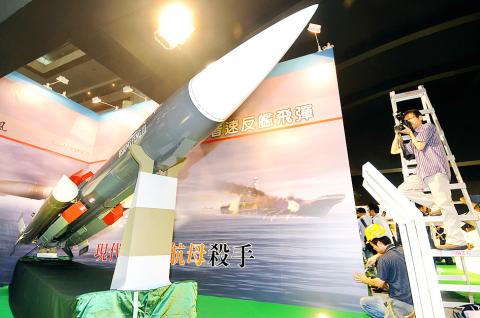|
More HF-3 missile
deployment mulled
‘BRAVE WIND’: The locally developed supersonic
anti-ship missile may be deployed on two more classes of frigate. China also
appears interested in developing such missiles
By Jake Chung / Staff writer, with CNA

The Hsiung Feng (“Brave Wind”)
III anti-ship missile is displayed at Taipei Aerospace and Defense Technology
Exhibition in Taipei in 2011.
Photo: Taipei Times
Additional deployment of the locally
developed Hsiung Feng III (HF-3) “Brave Wind” surface-to-surface supersonic
anti-ship missile on LaFayette-class Kang Ding and Chi Yang Knox-class frigates
within the year is being considered in the face of China’s increasing buildup of
its naval capabilities, the Ministry of National Defense said yesterday.
The HF-3 supersonic surface-to-surface missile had been under research and
development by the Chungshan Institute of Science and Technology (中山科學研究院) for
nearly two decades, and was made public in a military exercise in 2007.
While the ministry has not released any information on the capabilities of the
HF-3 missile, military magazines surmise that the missile may reach speeds of
between Mach 2.5 and Mach 3 at a range of between 150km and 200km.
The magazines also report that the missile might be equipped with an active
radar homing system and would be guided by the navy’s communication and
observation systems in a wartime situation, and, as such, the missile could be
considered a “fire-and-forget” type of missile.
According to an anonymous source who participated in the Hsiung Feng project,
the HF-3 is more precise than either of its predecessors — the Hsiung Feng I and
Hsiung Feng II — and is also superior in terms of its ability to penetrate the
defensive capabilities of enemy ships.
Commenting on the tight lid the military has kept on the missile’s capabilities
and specifications, the source said the difficulty in making supersonic missiles
lay not in the principle, but in the missiles’ exterior form and calibrations.
Nations all over the world have classified such information, and Taiwan is no
different, the source said.
The source added that the success of the Chungshan Institute in completing the
missile was an important milestone for the nation.
The ministry said that the missile has already been deployed on the Cheng
Kung-class frigate, the navy’s Perry-class frigates, the locally researched and
made Ching Chiang class, and the Kuang Hua VI-class fast attack missile craft
(光華六號).
The ministry is also considering deploying the HF-3 missiles on the two Oliver
Hazard Perry-class frigates that the ministry intends to purchase from the US
next year, ministry officials said.
Meanwhile, the ministry has professed concern that China also appears interested
in researching supersonic surface-to-surface missiles, adding that the success
of such a venture was extremely important to the military balance in the Taiwan
Strait.
|
![]()
![]()
![]()